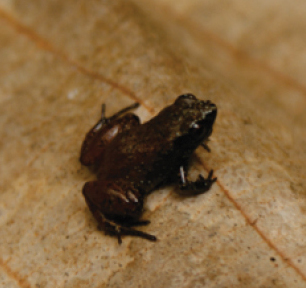
Stefania is a genus of frogs in the family Hemiphractidae. They are native to the highlands of the Guiana Shield in southern Venezuela, Guyana, and adjacent far northern Brazil. Most are restricted to the tepui highlands, but S. evansi also occurs in lowlands. On most mountains there are only 1–2 species from this genus, but five are known from Mount Ayanganna and the neighbouring Mount Wokomung has six species. They are usually found near streams at low levels on branches/leaves or on the ground among vegetation/rocks.
Vitreorana helenae is a species of frog in the family Centrolenidae. Two common names are sometimes used to refer to this species: Venezuelan glass frog and Helena's glass frog. In Spanish, it is locally known as ranita de cristal de Helena.
Warren's tree frog is a species of frog in the family Hylidae found in Guyana and possibly Brazil and Venezuela. Its natural habitats are subtropical or tropical moist montane forests, rivers, freshwater marshes, and intermittent freshwater marshes.
The Lema tree frog is a species of frog in the family Hylidae found in Guyana, Venezuela, and possibly Brazil. Its natural habitats are subtropical or tropical moist lowland forests, subtropical or tropical moist montane forests, rivers, pastureland, rural gardens, heavily degraded former forests, aquaculture ponds, and canals and ditches. It is threatened by habitat loss.
Hoogmoed's tree frog is a species of frog in the family Hylidae found in Guyana, possibly Brazil, and possibly Venezuela. Its natural habitats are subtropical or tropical moist montane forests and rivers.
The La Escalera tree frog is a species of frog in the family Hylidae found in Guyana, Venezuela, and possibly Brazil. Its natural habitats are subtropical or tropical moist lowland forests, subtropical or tropical moist montane forests, rivers, and freshwater marshes.
Nesorohyla is a monotypic genus of frogs in the family Hylidae. The sole species is Nesorohyla kanaima, also known as the Kanaima treefrog. It is endemic to Guyana. and possibly Brazil and Venezuela. Its natural habitats are subtropical or tropical moist lowland forests, subtropical or tropical moist montane forests, and rivers.

The Manaus slender-legged tree frog is a species of frog in the family Hylidae found in Bolivia, Brazil, Colombia, Ecuador, French Guiana, Guyana, Peru, Suriname, and Venezuela. Its natural habitats are subtropical or tropical dry forest, subtropical or tropical moist lowland forest, moist savanna, rivers, intermittent freshwater marshes, and canals and ditches. It is threatened by habitat loss. It is also reported to produce Bufotenin.

Adelophryne gutturosa is a species of frogs in the family Eleutherodactylidae. It is found on the Guiana Shield from eastern Venezuela through Guyana to French Guiana and adjacent Brazil (Amapá), possibly extending to Suriname. Its type locality is Mount Roraima. Its local Spanish name is ranita guturosa.
Stefania ackawaio is a species of frog in the family Hemiphractidae. It is endemic to Guyana. Its natural habitat is subtropical or tropical moist montane forests.
Stefania ayangannae is a species of frog in the family Hemiphractidae. It is endemic to Guyana where it is known from Mount Ayanganna and Mount Wokomung, both in the Pacaraima Mountains.
Stefania coxi is a species of frog in the family Hemiphractidae. It is endemic to Guyana and has been found on Mount Ayanganna and Mount Wokomung. Its natural habitat is subtropical or tropical moist montane forests at higher elevations.

Stefania evansi is a species of frog in the family Hemiphractidae. Stefania evansi is, along with other closely related frogs, known for its unusual reproductive mode where females carry the eggs and juveniles on their back. It is sometimes known under common names Groete Creek carrying frog, Groete Creek treefrog, or Evans' stefania. These names refer to its type locality, Groete Creek in the region Essequibo Islands-West Demerara, Guyana, where the holotype was collected by one Dr. R. Evans.
Stefania roraimae is a species of frog in the family Hemiphractidae. It is endemic to Guyana. Its type locality is Mount Roraima; it is also known from Mount Ayanganna and Mount Wokomung. It presumably occurs in the adjacent Venezuela and Brazil too.
Otophryne robusta is a species of frog in the family Microhylidae. It is found in Guyana, Venezuela, and possibly Brazil. Its natural habitats are tropical moist montane forests and rivers. It is threatened by habitat loss.
Otophryne steyermarki is a species of frog in the family Microhylidae. It is found in western Guyana and in the Bolívar state in eastern Venezuela.
Rhinatrema nigrum, the black caecilian, is a species of caecilian in the family Rhinatrematidae found in Guyana, Venezuela, and possibly Brazil. Its natural habitats are subtropical or tropical moist lowland forests, subtropical or tropical moist montane forests, rivers, and intermittent rivers.
Mount Wokomung is a sandstone tepui in the Pakaraima Mountains of western Guyana, the summit is 1700 metres. Together with Mount Ayanganna, 37 km to the north,
Yanomamia guianensis is a South American lizard of the family Gymnophthalmidae. It has been found only at higher elevations on Mount Ayanganna and Mount Roraima in west-central Guyana.

Adelophryne patamona is a species of frog in the family Eleutherodactylidae. It is endemic to the Pacaraima Mountains of southwestern Guyana, although it is likely to also occur in the adjacent Roraima state of Brazil. It is most closely related to A. gutturosa.




